Experimental and Analytical Investigations of the Use of Groove-Epoxy Anchorage System for Shear Strengthening of RC Beams Using CFRP Laminates
Abstract
:1. Introduction and Background
2. Materials and Methods
2.1. Specimen Details and Test Matrix
2.1.1. Specimen Details
2.1.2. Specimens Designation and Test Matrix
2.2. Material Properties
2.2.1. Concrete
2.2.2. Steel
2.2.3. CFRP and Epoxy
2.3. Specimen Preparation
2.4. Test Setup and Instrumentations
3. Experimental Results and Discussion
3.1. Summary of Experimental Results
3.2. Load Deflection Relationships and Modes of Failure
3.2.1. Specimens C, S-EBR and P-EBR
3.2.2. Specimens PGT, PGM and PGD
3.2.3. Specimens SGT, SGM and SGD
4. Load Strain Relationships
5. Models for Prediction of Shear-Strength of Groove-Epoxy Anchorage
5.1. ACI440.2R Prediction of Shear-Strength Capacity of RC Beams
5.2. Proposed Model for Predicting Shear Capacity of CFRP Plate on Groove-Epoxy
5.3. Model for Predicting Shear Capacity of CFRP Sheet on Groove-Epoxy
6. Summary and Conclusions
- Using the EBR conventional method showed an increase in the shear capacity over the control beam by 39.28% and 62.48% for CFRP plates and sheets strengthened specimens, respectively.
- When CFRP plates are used, groove-epoxy anchors had increased the shear capacity up to 112.29% over the control beam and 52.42% over the EBR strengthened beam. While CFRP sheet specimens showed an increase of 141.01 and 48.36% over the control and EBR strengthened specimens, respectively.
- The groove-epoxy anchorage system increased the shear-strength contribution of CFRP without grooves in the range of 30–190% for CFRP plates and 40–100% for CFRP sheets.
- Generally, the contributions of groove-epoxy on shear-strength decreases with the increase of groove width, with the medium groove specimens showed the best performance among the other groove sizes.
- All specimens failed in shear with a major diagonal shear crack, followed by CFRP sheets or plates debonding, or delamination and some combination of small flexural and flexural-shear cracks.
- The groove-epoxy method changed the mode of failure from debonding to delamination for almost all specimens and delayed the early debonding failure of CFRP sheets and plates for others, and consequently increased the beams’ shear strength and maximum deflection.
- The developed shear-strength prediction models incorporated groove factors as a modifier to the FRP shear-strength contribution of ACI-440 shear equation. The developed models predicted the experimental shear-strength of RC beams with the utilized groove-epoxy systems with a good level of accuracy, with an average MAPE = 3.31% and 6.68%, NMSE = 0.072, 0.523 and coefficient of determination R2 = 0.964, 0.691, for plates and sheets, respectively.
Author Contributions
Funding
Acknowledgments
Conflicts of Interest
References
- Hollaway, L.C. A review of the present and future utilisation of FRP composites in the civil infrastructure with reference to their important in-service properties. Constr. Build. Mater. 2010, 24, 2419–2445. [Google Scholar] [CrossRef]
- Pendhari, S.S.; Kant, T.; Desai, Y.M. Application of polymer composites in civil construction: A general review. Compos. Struct. 2008, 84, 114–124. [Google Scholar] [CrossRef]
- Naser, M.; Hawileh, R.A.; Abdalla, J.A. Use of Fiber-Reinforced Polymer Composites in Strengthening Reinforced Concrete Structures: A Critical Review. J. Eng. Struct. 2019, 198, 109542. [Google Scholar] [CrossRef]
- Siddika, A.; Al Mamun, M.A.; Alyousef, R.; Amran, Y.M. Strengthening of reinforced concrete beams by using fiber-reinforced polymer composites: A review. J. Build. Eng. 2019, 25, 100798. [Google Scholar] [CrossRef]
- Cauich, P.J.P.; Martínez-Molina, R.; Marrufo, J.L.G.; Franco, P.J.H. Adhesion, strengthening and durability issues in the retrofitting of Reinforced Concrete (RC) beams using Carbon Fiber Reinforced Polymer (CFRP)–A Review. Rev. ALCONPAT 2019, 9, 130–151. [Google Scholar] [CrossRef] [Green Version]
- Czaderski, C.; Meier, H. EBR Strengthening Technique for Concrete, Long-Term Behaviour and Historical Survey. Polymers 2018, 10, 77. [Google Scholar] [CrossRef] [Green Version]
- Meier, U. Strengthening of structures using carbon fibre/epoxy composites. Constr. Build. Mater. 1995, 9, 341–351. [Google Scholar] [CrossRef]
- Rahim, N.I.; Mohammed, B.S.; Al-Fakih, A.; Wahab, M.M.A.; Liew, M.S.; Anwar, A.; Amran, Y.H.M. Strengthening the Structural Behavior of Web Openings in RC Deep Beam Using CFRP. Materials 2020, 13, 2804. [Google Scholar] [CrossRef]
- Chalioris, C.E.; Zapris, A.G.; Karayannis, C.G. U-Jacketing Applications of Fiber-Reinforced Polymers in Reinforced Concrete T-Beams against Shear—Tests and Design. Fibers 2020, 8, 13. [Google Scholar] [CrossRef] [Green Version]
- Barros, J.A.O.; Dias, S.J.E.; Lima, J.L.T. Efficacy of CFRP-based techniques for the flexural and shear strengthening of concrete beams. Cem. Concr. Compos. 2007, 29, 203–217. [Google Scholar] [CrossRef]
- Alzoubi, F.; Zhengliang, L. Overview Shear Strengthening of RC Beams with Externally Bonded FRP Composites. J. Appl. Sci. 2007, 7, 1093–1106. [Google Scholar] [CrossRef] [Green Version]
- Jumaat, M.Z.; Rahman, M.M.; Rahman, M.A. Review on bonding techniques of CFRP in strengthening concrete structures. Int. J. Phys. Sci. 2011, 6, 3567–3575. [Google Scholar] [CrossRef]
- Mohammed, A.; Abdalla, J.A.; Hawileh, R.A.; Nawaz, W. Reinforced Concrete Beams Externally Strengthened in Flexure using Hybrid Systems. In Proceedings of the ASET 2018 First Multi Conference on Advances in Science and Engineering Technology-Advanced Materials, Design and Manufacturing International Conference, Dubai, UAE, 6–7 February 2018. [Google Scholar]
- Önal, M.M. Strengthening Reinforced Concrete Beams with CFRP and GFRP. Adv. Mater. Sci. Eng. 2014, 8. [Google Scholar] [CrossRef] [Green Version]
- Piątek, B.; Siwowski, T.; Michałowski, J.; Błażewicz, S. Development of Bonded/Riveted Steel Anchorages of Prestressed CFRP Strips for Concrete Strengthening. Materials 2020, 13, 2217. [Google Scholar] [CrossRef]
- Jones, R.; Swamy, R.N.; Charif, A. Plate separation and anchorage of reinforced concrete beams strengthened by epoxy-bonded steel plates. Struct. Eng. 1988, 66, 85–94. Available online: http://worldcat.org/issn/14665123 (accessed on 12 January 2018).
- Hawileh, R.A.; Nawaz, W.; Abdalla, J.A. Flexural behavior of reinforced concrete beams externally strengthened with Hardwire Steel-Fiber sheets. Constr. Build. Mater. 2018, 172, 562–573. [Google Scholar] [CrossRef]
- Barnes, R.A.; Mays, G.C. Strengthening of reinforced concrete beams in shear by the use of externally bonded steel plates: Part 2–Design guidelines. Constr. Build. Mater. 2006, 20, 403–411. [Google Scholar] [CrossRef]
- Aykac, S.; Kalkan, I.; Aykac, B.; Karahan, S.; Kayar, S. Strengthening and repair of reinforced concrete beams using external steel plates. J. Struct. Eng. 2013, 139, 929–939. [Google Scholar] [CrossRef]
- Rakgate, S.M.; Dundu, M. Strength and ductility of simple supported R/C beams retrofitted with steel plates of different width-to-thickness ratios. Eng. Struct. 2018, 157, 192–202. [Google Scholar] [CrossRef]
- Abdalla, J.A.; Hraib, F.H.; Hawileh, R.A.; Mirghani, A.M. Experimental investigation of bond-slip behavior of aluminum plates adhesively bonded to concrete. J. Adhes. Sci. Technol. 2017, 31, 82–99. [Google Scholar] [CrossRef]
- Fayed, S.; Basha, A.; Hamoda, A. Shear strengthening of RC beams using aluminum plates: An experimental work. Constr. Build. Mater. 2019, 221, 122–138. [Google Scholar] [CrossRef]
- Abdalla, J.A.; Abou-Obeidah, A.S.; Hawileh, R.A. Behavior of Shear Deficient Reinforced Concrete Beams with Externally Bonded Aluminum Alloy Plates. In Proceedings of the 2011 World Congress on Advances in Structural Engineering and Mechanics, Seoul, Korea, 18–23 September 2011. [Google Scholar]
- Chang, H.; Zhou, W. Flexural Behaviour of Unbonded Posttensioned Concrete Beam Strengthened with Aluminium Alloy Plates. Math. Probl. Eng. 2020, 13. [Google Scholar] [CrossRef]
- Abu-Obeidah, A.S.; Abdalla, J.A.; Hawileh, R.A. Shear strengthening of deficient concrete beams with marine grade aluminum alloy plates. Adv. Concr. Constr. 2019, 7, 249–262. [Google Scholar] [CrossRef]
- Abdalla, J.A.; Abu-Obeidah, A.S.; Hawileh, R.A.; Rasheed, H.A. Shear strengthening of reinforced concrete beams using externally-bonded aluminum alloy plates: An experimental study. Constr. Build. Mater. 2016, 128, 24–37. [Google Scholar] [CrossRef]
- Zhu, J.H.; Wei, L.L.; Zhu, M.C.; Li, W.W.; Xing, F. Experimental study of bond behavior on aluminum alloy plate-to-concrete interface. Appl. Mech. Mater. 2014, 501, 805–810. [Google Scholar] [CrossRef]
- Abdalla, J.A.; Abu-Obeidah, A.S.; Hawileh, R.A. Use of Aluminum Alloy Plates as Externally Bonded Shear Reinforcement for R/C Beams. Procedia Struct. Integr. 2019, 17, 403–410. [Google Scholar] [CrossRef]
- Rasheed, H.A.; Abdalla, J.A.; Hawileh, R.A.; Al-Tamimi, A.K. Flexural Behavior of Reinforced Concrete Beams Strengthened with Externally Bonded Aluminum Alloy Plates. Eng. Struct. 2017, 147, 473–485. [Google Scholar] [CrossRef]
- Grelle, S.V.; Sneed, L.H. Review of Anchorage Systems for Externally Bonded FRP Laminates. Int. J. Concr. Struct. Mater. 2013, 7, 17–33. [Google Scholar] [CrossRef] [Green Version]
- Kalfat, R.; Al-Mahaidi, R.; Smith, S. Anchorage Devices Used to Improve the Performance of Reinforced Concrete Beams Retrofitted with FRP Composites: State-of-the-Art Review. J. Compos. Constr. 2013, 17, 14–33. [Google Scholar] [CrossRef]
- Mohee, F.M.; Al-Mayah, A.; Plumtree, A. Anchors for CFRP plates: State-of-the-art review and future potential. Compos. Part B Eng. 2016, 90, 432–442. [Google Scholar] [CrossRef]
- Banijamali, S.M.; Esfahani, M.R.; Nosratollahi, S.; Sohrabi, M.R.; Mousavi, S.R. Reviewing the FRP strengthening systems. Am. J. Civ. Eng. 2015, 3, 38–43. [Google Scholar] [CrossRef]
- Ali, A.; Abdalla, J.A.; Hawileh, R.A.; Galal, K. CFRP Mechanical Anchorage for Externally Strengthened RC Beams under Flexure. Phys. Procedia 2014, 55, 10–16. [Google Scholar] [CrossRef] [Green Version]
- Mhanna, H.H.; Hawileh, R.A.; Abdalla, J.A. Shear Strengthening of Reinforced Concrete Beams Using CFRP Wraps. Procedia Struct. Integr. 2019, 172019, 214–221. [Google Scholar] [CrossRef]
- Mohamed, K.; Abdalla, J.A.; Hawileh, R.A.; Nawaz, W. Using bore-epoxy anchorage to delay debonding of CFRP plates strengthened concrete beams. In Proceedings of the ASET 2018 First Multi Conference on Advances in Science and Engineering Technology-Advanced Materials, Design and Manufacturing International Conference, Dubai, UAE, 6–7 February 2018; Available online: https://ieeexplore.ieee.org/abstract/document/8376863 (accessed on 20 August 2018).
- Koutas, L.; Triantafillou, T.C. Use of anchors in shear strengthening of reinforced concrete T-beams with FRP. J. Compos. Constr. 2013, 17, 101–107. [Google Scholar] [CrossRef]
- Kim, Y.; Quinn, K.; Ghannoum, W.M.; Jirsa, J.O. Strengthening of reinforced concrete T-beams using anchored CFRP materials. ACI Struct. J. 2014, 111, 1027. [Google Scholar] [CrossRef]
- Chen, G.M.; Zhang, Z.; Li, Y.L.; Li, X.Q.; Zhou, C.Y. T-section RC beams shear-strengthened with anchored CFRP U-strips. Compos. Struct. 2016, 144, 57–79. [Google Scholar] [CrossRef]
- Hawileh, R.A.; Nawaz, W.; Abdalla, J.A.; Saqan, E.I. Effect of Flexural CFRP Sheets on Shear Resistance of Reinforced Concrete Beams. Compos. Struct. 2015, 122, 468–476. [Google Scholar] [CrossRef]
- Hawileh, R.; Nawaz, W.; Abdalla, J.; Saqan, E. External Strengthening of Shear Deficient Reinforced Concrete Beams with Flexural CFRP Laminates. In Response of Structures under Extreme Loading. Proceedings of the 5th International Workshop on Performance, Protection & Strengthening of Structures under Extreme Loading (PROTECT 2015), East Lansing, MI, USA, 28–30 June 2015; DEStech Publications, Inc.: Lancaster, PA, USA, 2015; pp. 368–373. Available online: http://hdl.handle.net/11073/16369 (accessed on 8 July 2016).
- Nawaz, W.; Hawileh, R.; Saqan, E.I.; Abdalla, J.A. Effect of Longitudinal CFRP Plates on the Shear Strength of RC Beams. ACI Struct. J. 2016, 113, 577–586. [Google Scholar] [CrossRef]
- Saqan, E.; Nawaz, W.; Hawileh, R.; Abdalla, J. Evaluation of the contribution of flexural CFRP plates in shear strengthening RC beams. In Proceedings of the Third Conference on Smart Monitoring, Assesment and Rehabilitation of Civil Structures (SMAR 2015), Antalya, Turkey, 7–9 September 2015; p. 275. Available online: http://hdl.handle.net/11073/16235 (accessed on 10 June 2016).
- Hosseini, A.; Mostofinejad, D. Experimental investigation into bond behavior of CFRP sheets attached to concrete using EBR and EBROG techniques. Compos. Part B Eng. 2013, 51, 130–139. [Google Scholar] [CrossRef]
- Mostofinejad, D.; Kashani, A.T. Experimental study on effect of EBR and EBROG methods on debonding of FRP sheets used for shear strengthening of RC beams. Compos. Part B Eng. 2013, 45, 1704–1713. [Google Scholar] [CrossRef]
- Mostofinejad, D.; Amirali, M.S.; Tabatabaei, K.A. Grooving Method to Postpone Debonding of FRP Sheets Used for Shear Strengthening. Proc. World Acad. Sci. Eng. Technol. 2012, 6, 795–799. [Google Scholar]
- Moghaddas, A.; Mostofinejad, D. Empirical FRP-concrete bond strength model for externally bonded reinforcement on grooves. J. Compos. Constr. 2019, 23, 04018080. [Google Scholar] [CrossRef]
- Riahi, A.T.; Moshiri, N.; Czaderski, C.; Mostofinejad, D. Effect of the EBROG method on strip-to-concrete bond behavior. Constr. Build. Mater. 2019, 220, 701–771. [Google Scholar] [CrossRef]
- Moshiri, N.; Riahi, A.T.; Mostofinejad, D.; Czaderski, C.; Motavalli, M. Experimental and analytical study on CFRP strips-to-concrete bonded joints using EBROG method. Compos. Part B Eng. 2019, 158, 437–447. [Google Scholar] [CrossRef]
- Czaderski, C.; Moshiri, N.; Hosseini, A.; Mostofinejad, D.; Motavalli, M. EBROG technique to enhance the bond performance of CFRP strips to concrete substrate. In Proceedings of the 5th International Conference on Smart Monitoring, Assessment and Rehabilitation of Civil Structures (SMAR 2019), Potsdam, Germany, 27–29 August 2019. [Google Scholar]
- Mostofinejad, D.; Hosseini, S.A.; Razavi, S.B. Influence of different bonding and wrapping techniques on performance of beams strengthened in shear using CFRP reinforcement. Constr. Build. Mater. 2016, 116, 310–320. [Google Scholar] [CrossRef]
- Mostofinejad, D.; Shameli, S.M. Externally bonded reinforcement in grooves (EBRIG) technique to postpone debonding of FRP sheets in strengthened concrete beams. Constr. Build. Mater. 2013, 38, 751–758. [Google Scholar] [CrossRef]
- MAPEI Technical Worksheet. Available online: https://www.mapei.com/it/en/products-and-solutions/products/detail (accessed on 15 June 2016).
- American Concrete Institute. ACI 440.2R-17. Guide for the Design and Construction of Externally Bonded FRP Systems for Strengthening Concrete Structures; American Concrete Institute: Farmington Hills, MI, USA, 2017. [Google Scholar]
- Khalifa, A.; Gold, W.J.; Nanni, A.; Abdelaziz, M.I. Contribution of externally bonded FRP to shear capacity of RC flexural members. J. Compos. Constr. 1998, 2, 195–202. [Google Scholar] [CrossRef] [Green Version]
- Bazant, Z.P.; Kim, J.K. Size effect in shear failure of longitudinally reinforced beams. ACI J. 1984, 81, 456–468. [Google Scholar]
- Bazant, Z.P.; Kazemi, M.T. Size effect on diagonal shear failure of beams without stirrups. ACI Struct. J. 1991, 88, 268–276. [Google Scholar]
- Zararis, P.D.; Papadakis, G.C. Diagonal shear failure and size effect in RC beams without web reinforcement. J. Struct. Eng. 2001, 127, 733–742. [Google Scholar] [CrossRef]
- Bažant, Z.P.; Yu, Q. Designing against size effect on shear strength of reinforced concrete beams without stirrups: I. Formulation. J. Struct. Eng. 2005, 131, 1877–1885. [Google Scholar] [CrossRef] [Green Version]
- Bentz, E.C. Empirical modeling of reinforced concrete shear strength size effect for members without stirrups. ACI Struct. J. 2005, 102, 232–241. [Google Scholar]
- Matta, F.; El-Sayed, A.K.; Nanni, A.; Benmokrane, B. Size Effect on Concrete Shear Strength in Beams Reinforced with Fiber-Reinforced Polymer Bars. ACI Struct. J. 2013, 110, 617–628. [Google Scholar]
- Alam, M.S.; Hussein, A. Size effect on shear strength of FRP reinforced concrete beams without stirrups. J. Compos. Constr. 2013, 17, 507–516. [Google Scholar] [CrossRef]
- Syroka-Korol, E.; Tejchman, J. Experimental investigations of size effect in reinforced concrete beams failing by shear. Eng. Struct. 2014, 58, 63–78. [Google Scholar] [CrossRef]

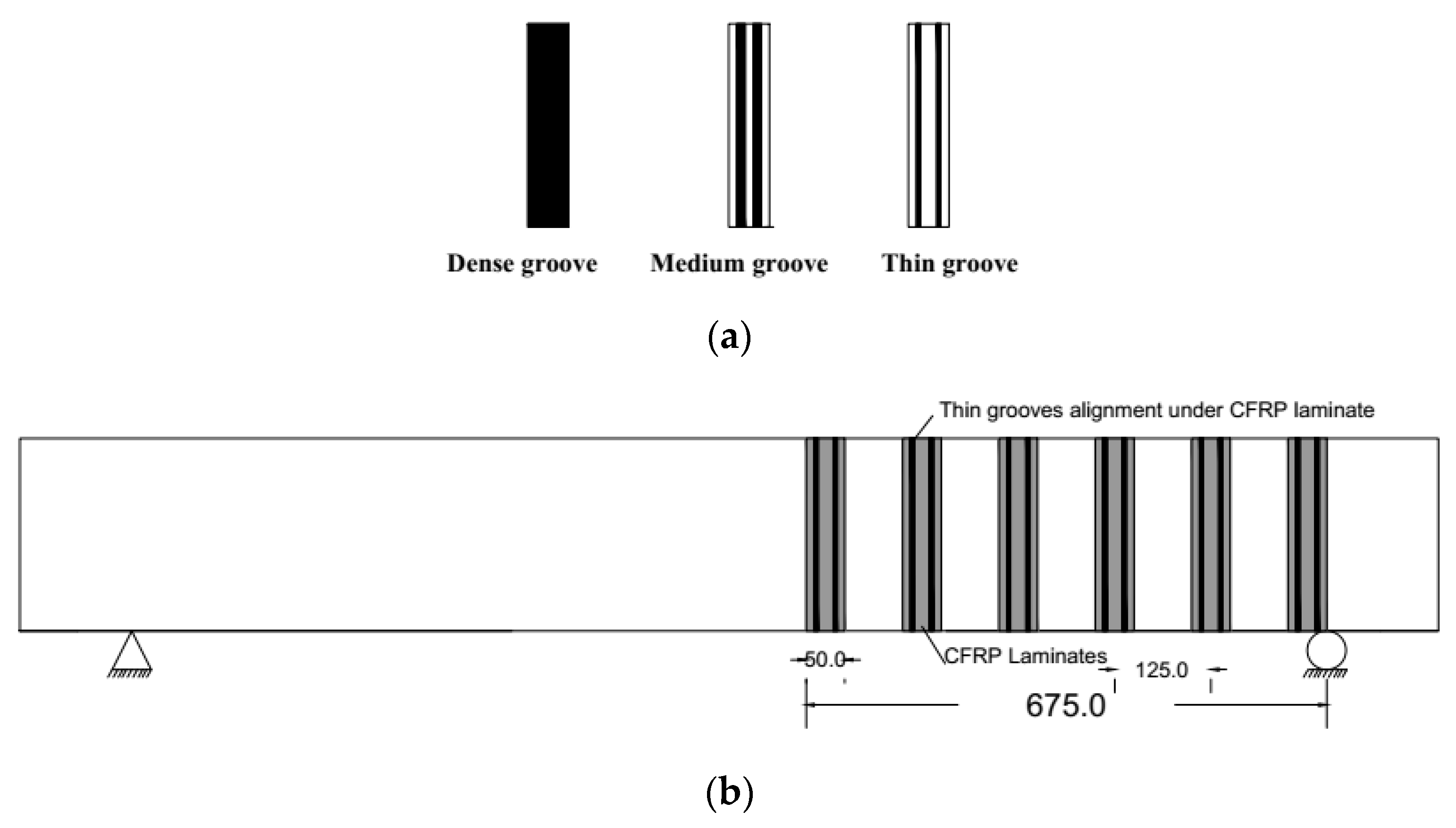
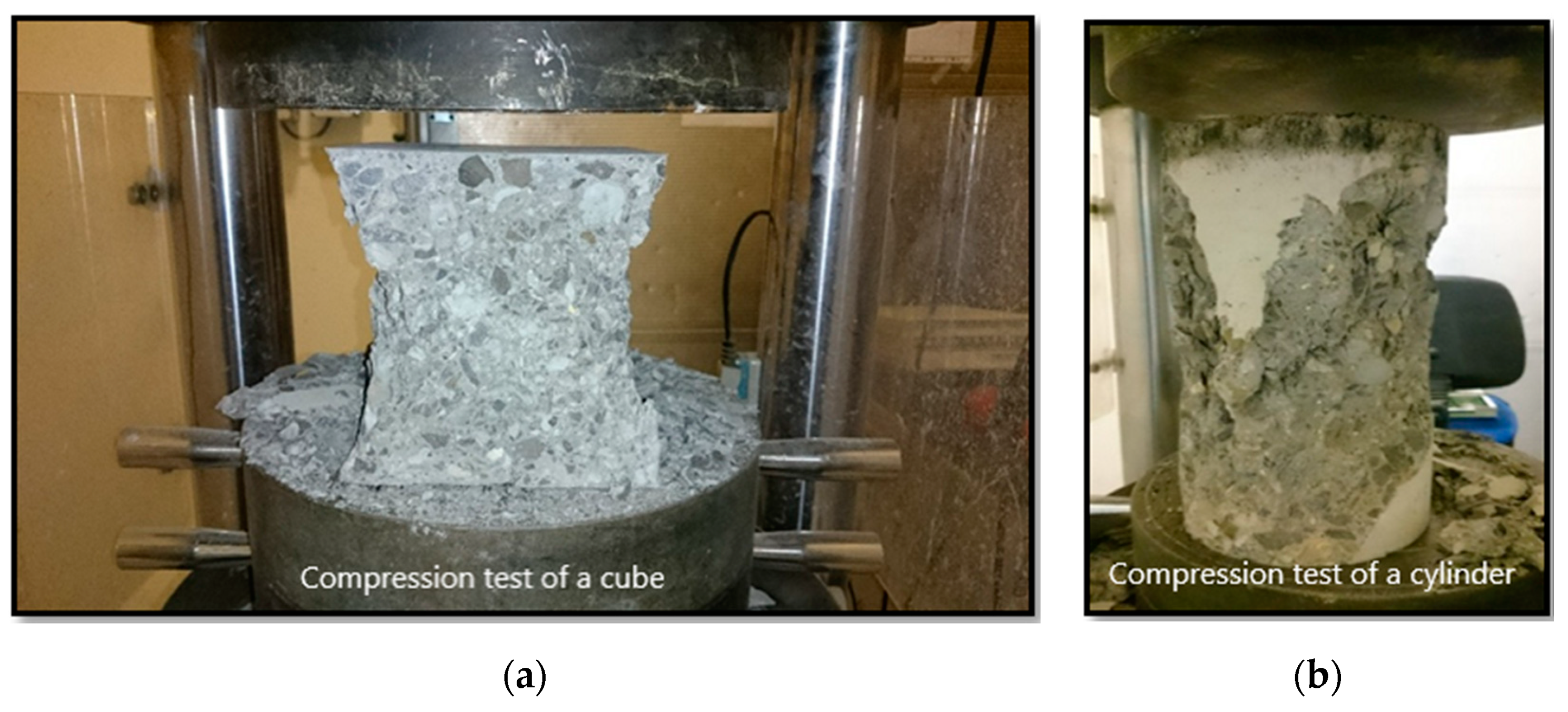
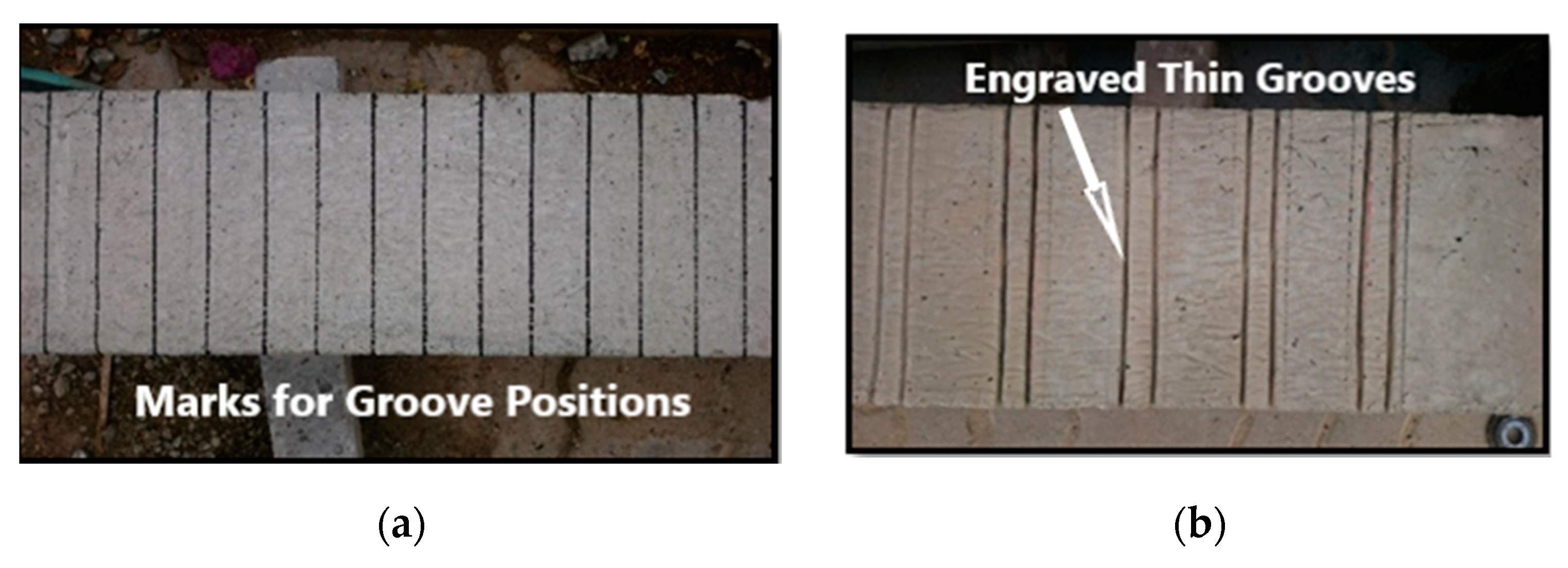


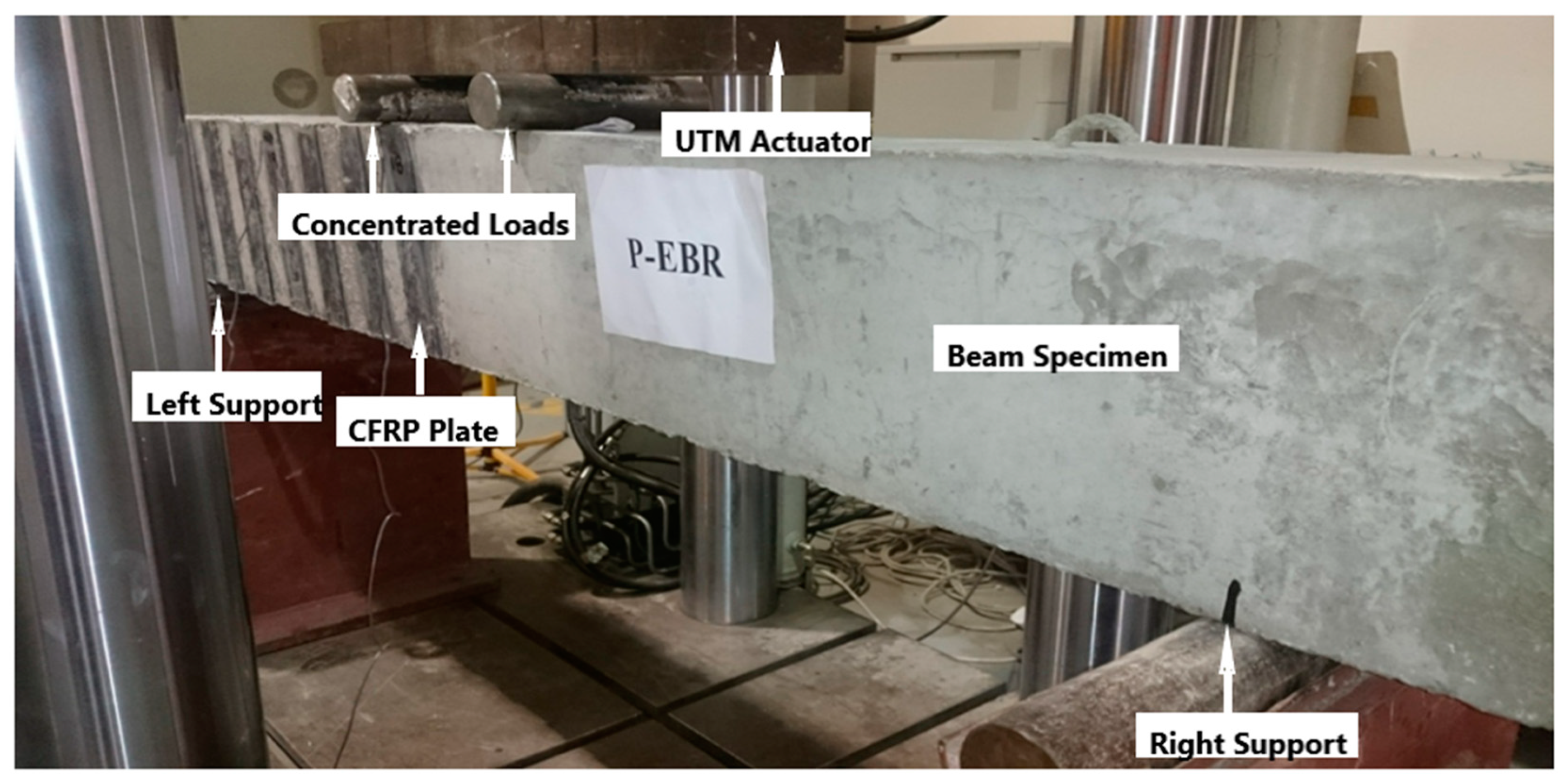
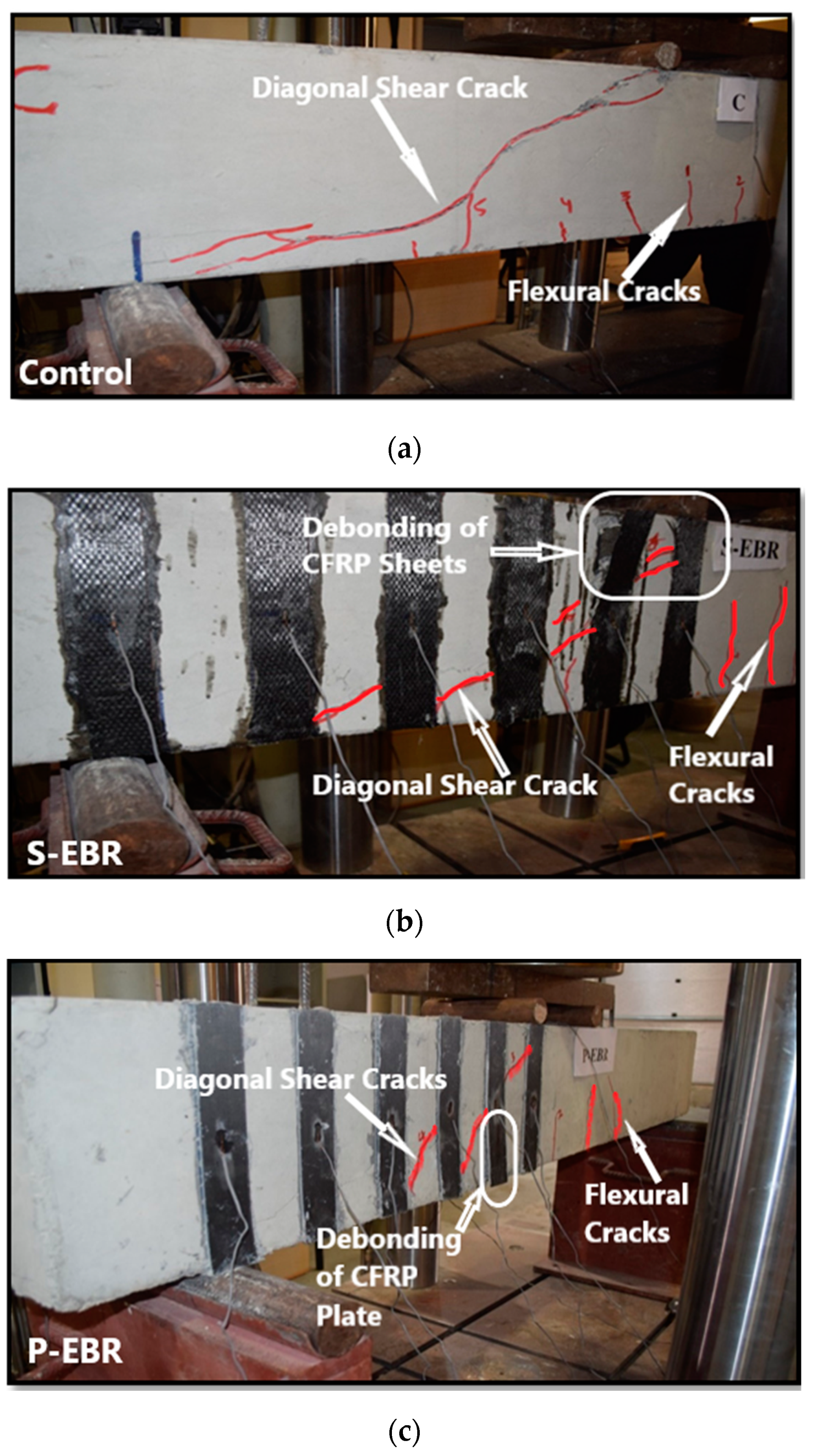

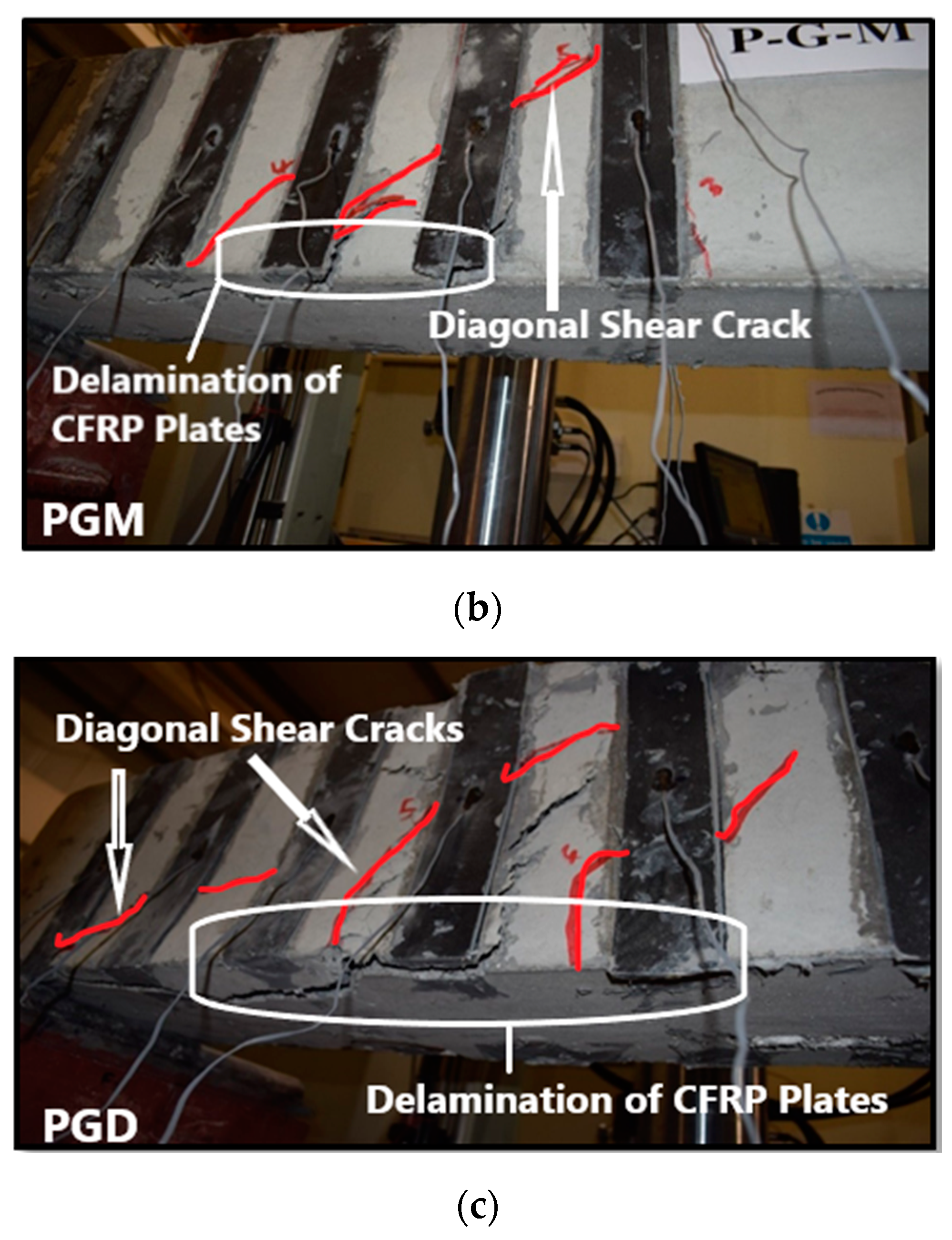
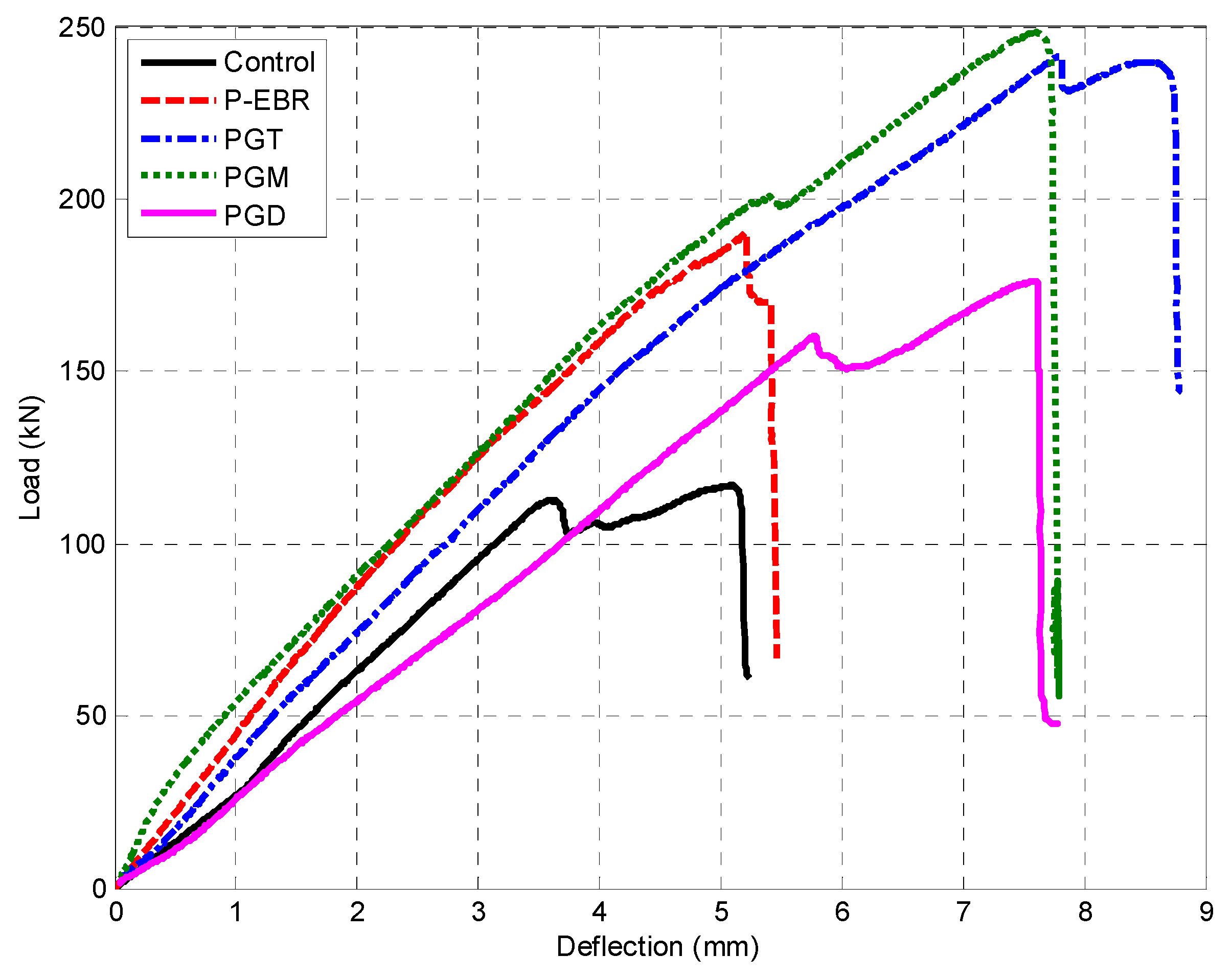

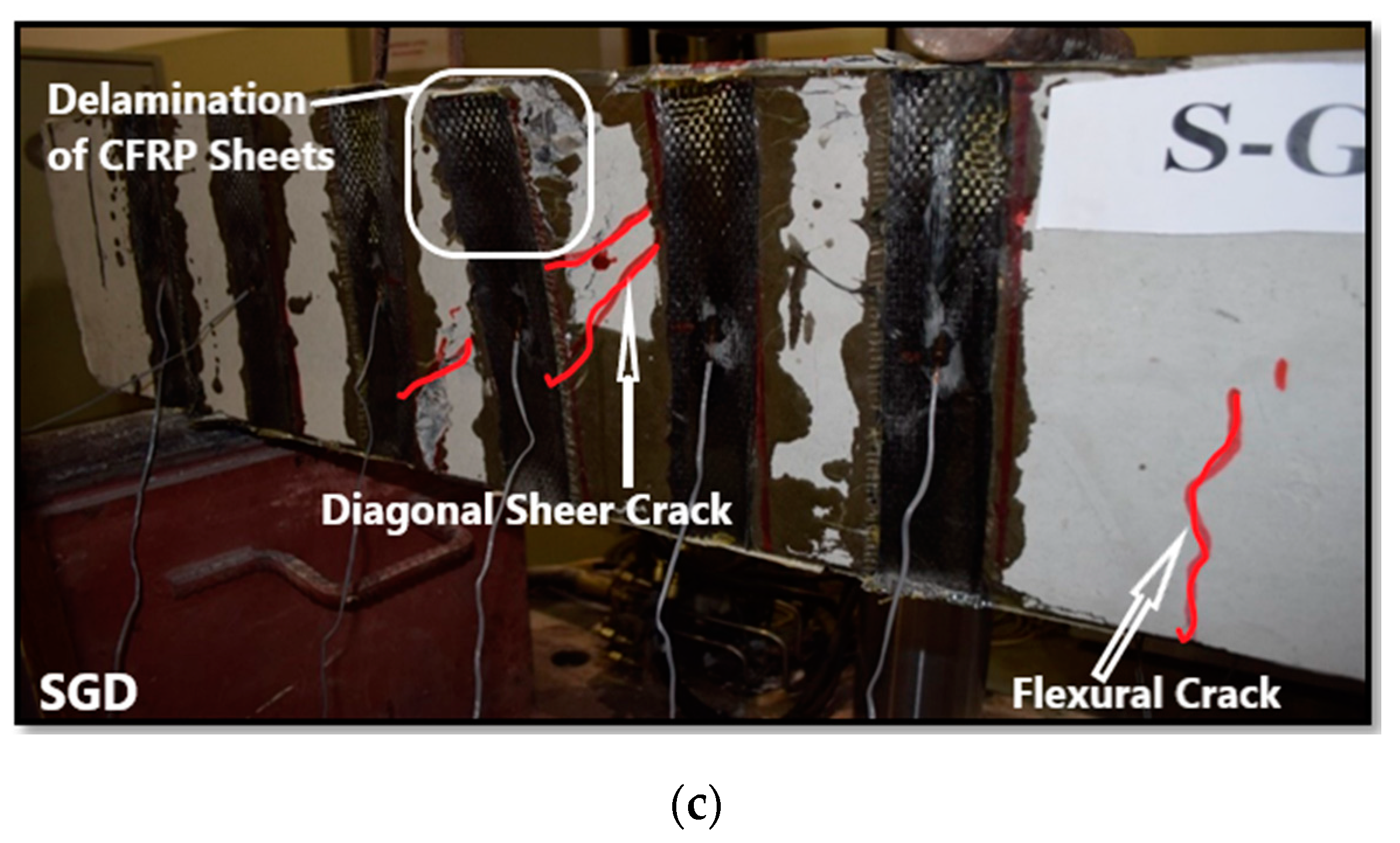
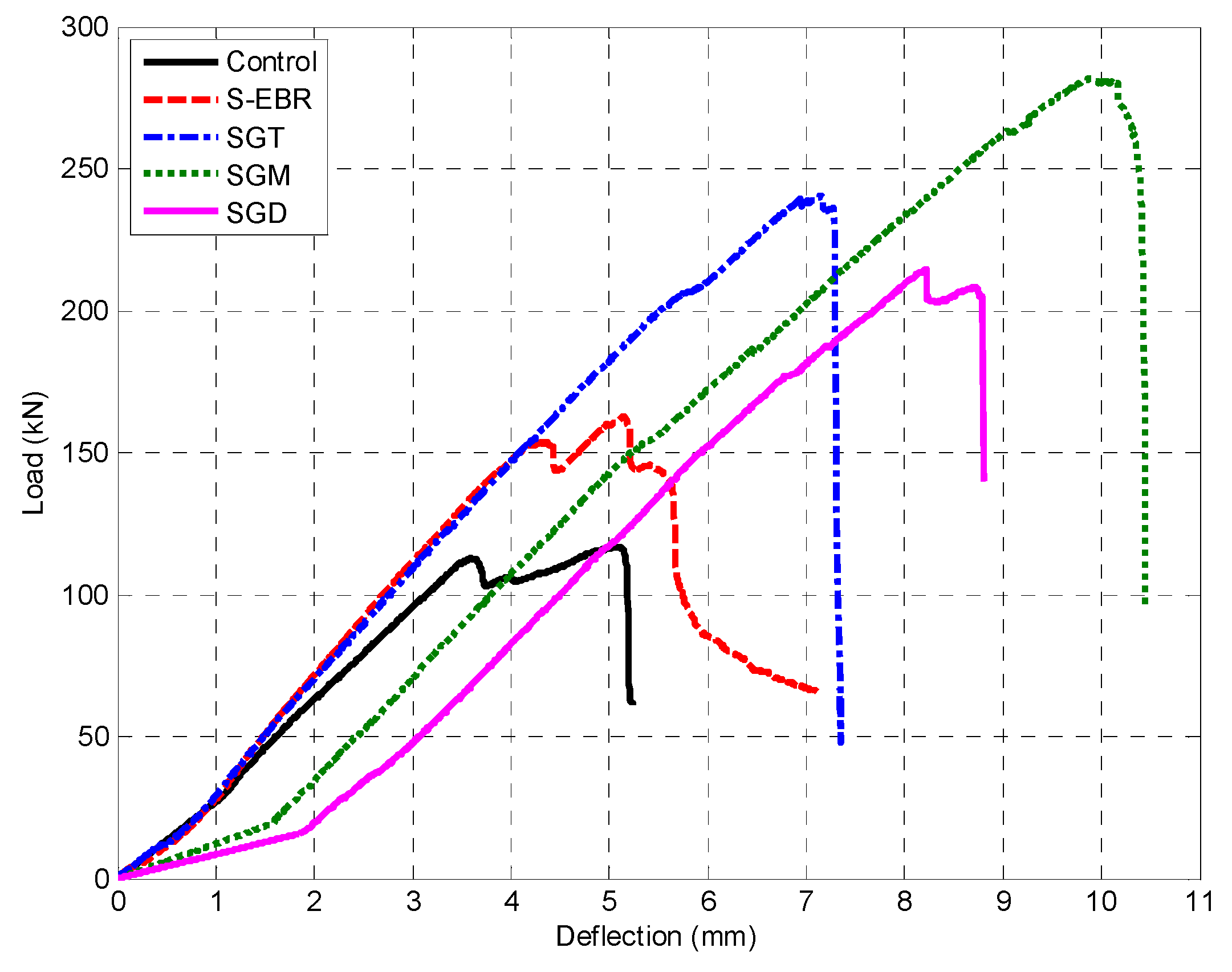
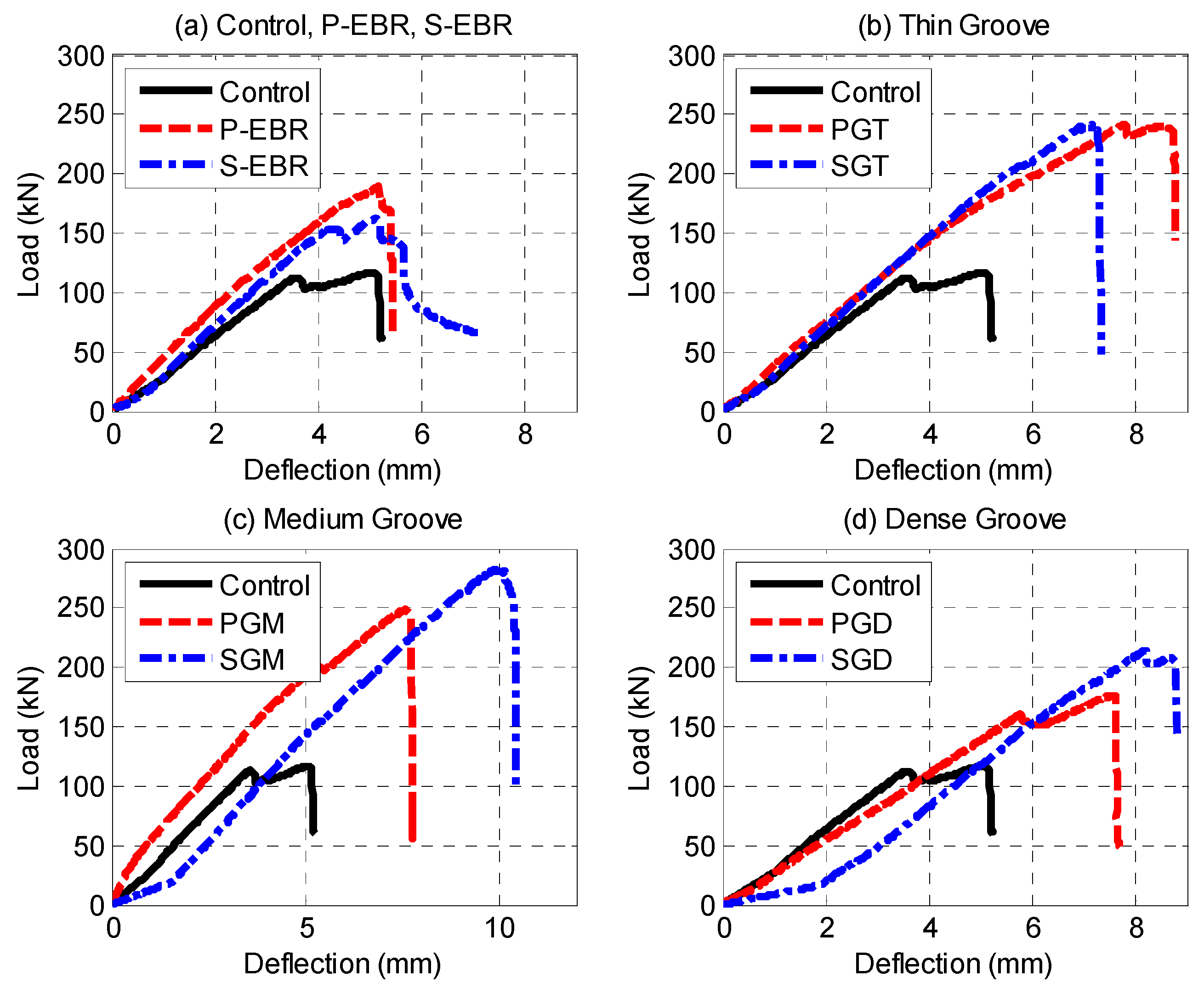
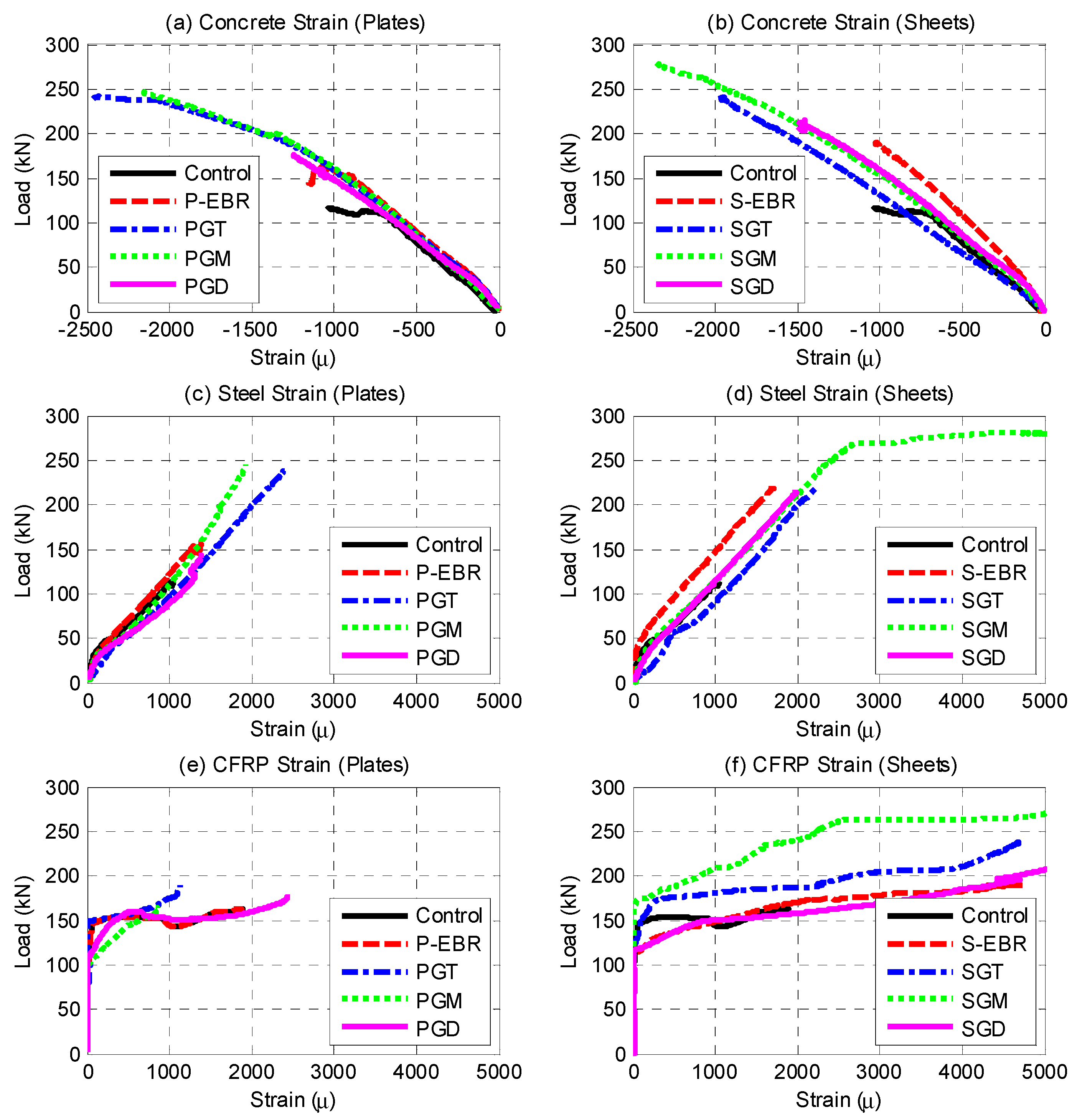
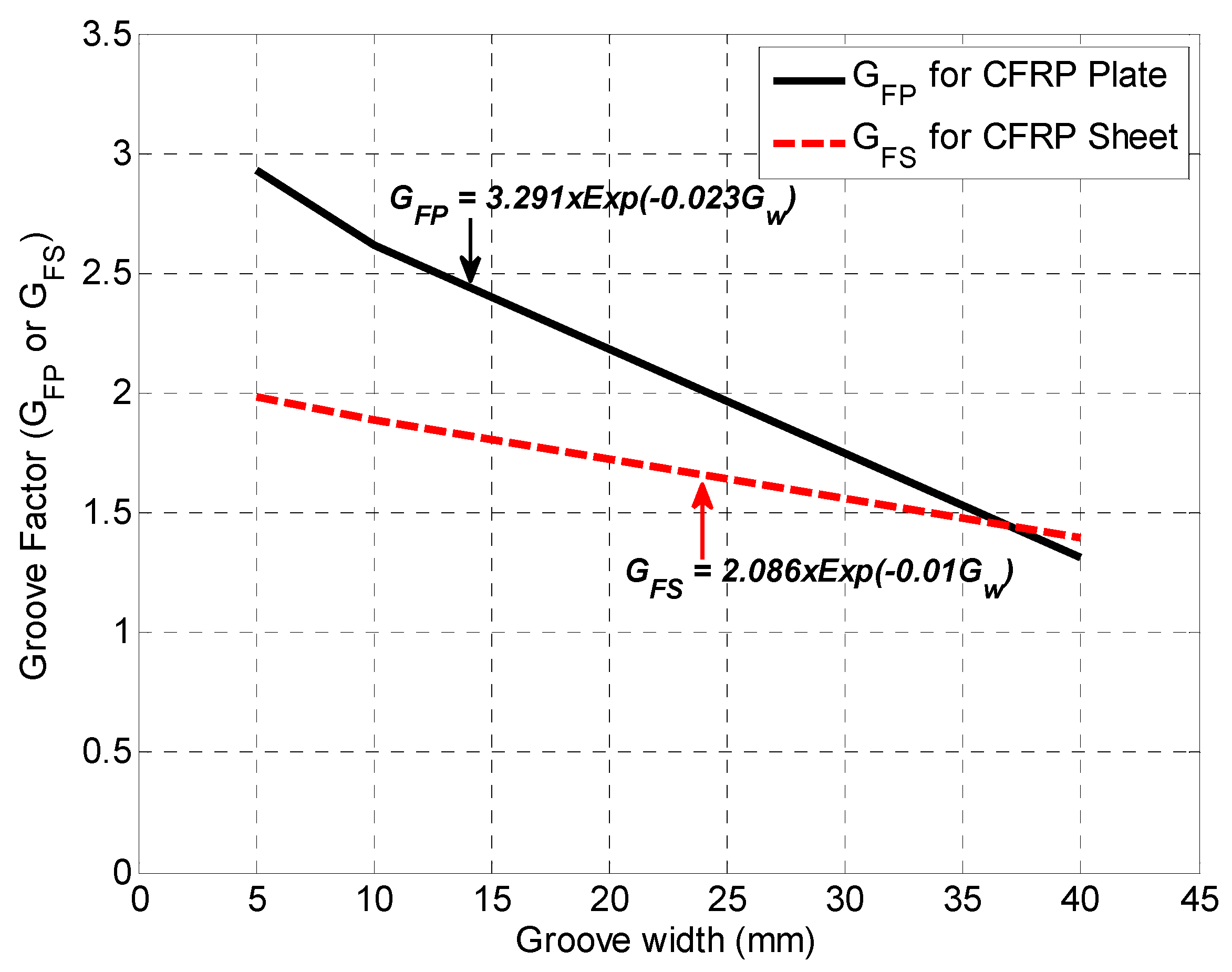
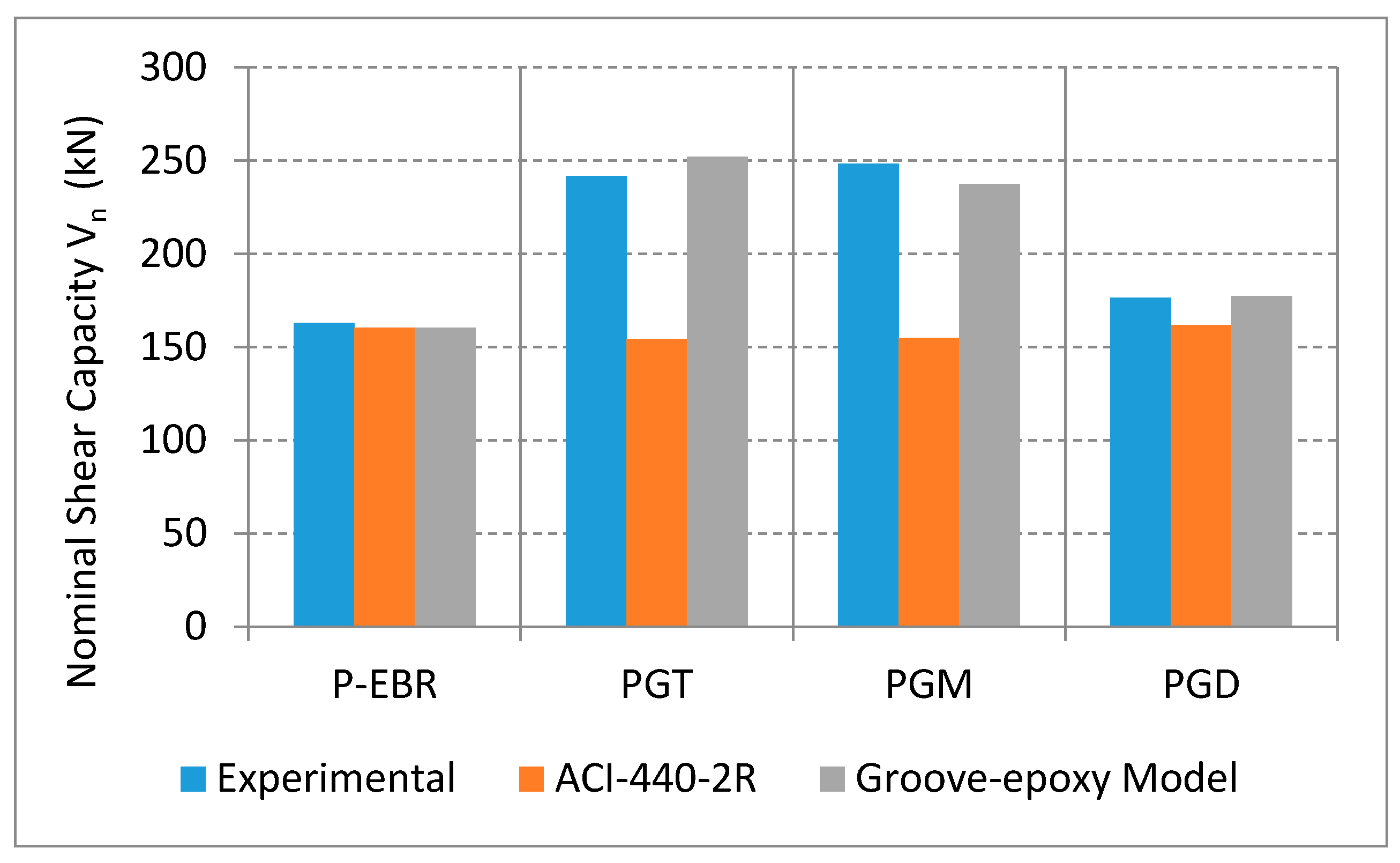

| No | Specimen | FRP Type | Strengthening Technique | Groove Width (mm) | FRP Width (mm) | FRP Spacing Sf (mm) |
|---|---|---|---|---|---|---|
| 1 | C1 | — | Control Beam Unstrengthen | — | — | — |
| 2 | S-EBR | Sheet | EBR | — | 50 | 125.0 |
| 3 | SGT | Sheet | Thin Groove-Epoxy Anchor | 5 | 50 | 125.0 |
| 4 | SGM | Sheet | Medium Groove-Epoxy Anchor | 10 | 50 | 125.0 |
| 5 | SGD | Sheet | Dense Groove-Epoxy Anchor | 40 | 50 | 125.0 |
| 6 | P-EBR | Plate | EBR | — | 50 | 125.0 |
| 7 | PGT | Plate | Thin Groove-Epoxy Anchor | 5 | 50 | 125.0 |
| 8 | PGM | Plate | Medium Groove-Epoxy Anchor | 10 | 50 | 125.0 |
| 9 | PGD | Plate | Dense Groove-Epoxy Anchor | 40 | 50 | 125.0 |
| Material | Thickness (mm) | Modulus of Elasticity (GPa) | Ultimate Tensile Strength (MPa) | Elongation at Failure (%) | Density (g/cm3) |
|---|---|---|---|---|---|
| CFRP Sheets | 0.17 | 230 | 4800 | 2.0 | 1.79 |
| CFRP Plates | 1.40 | 170 | 3100 | 2.0 | 1.61 |
| Adesilex PG2 | - | 6 | ≥18 | - | 1.70 |
| Mapewrap 31- | - | ≥3 | ≥40 | ≥1.6 | 1.06 |
| No | Specimen | Load (kN) | Deflection (mm) | Increase over Control Beam (%) | Increase over EBR Beams (%) | Failure Mode |
|---|---|---|---|---|---|---|
| 1 | C | 116.96 | 5.24 | — | — | Major shear crack |
| 2 | P-EBR | 162.90 | 7.10 | 39.3 | — | Major shear crack + CFRP debonding |
| 3 | PGT | 241.68 | 8.77 | 106.6 | 48.4 | Major shear crack + CFRP delamination |
| 4 | PGM | 248.30 | 7.79 | 112.4 | 52.4 | Major shear crack + CFRP delamination |
| 5 | PGD | 176.30 | 7.72 | 50.7 | 8.2 | Major shear crack + CFRP delamination |
| 6 | S-EBR | 190.04 | 5.85 | 62.5 | — | Major shear crack + CFRP debonding |
| 7 | SGT | 240.60 | 7.35 | 105.7 | 26.6 | Major shear crack + CFRP delamination |
| 8 | SGM | 281.89 | 10.93 | 141.0 | 48.3 | Major shear crack + CFRP delamination |
| 9 | SGD | 214.56 | 8.85 | 83. 5 | 12.9 | Major shear crack + CFRP delamination |
| No. | Specimen | Maximum Strain in Concrete (μs) | Maximum Strain in Steel (μs) | Maximum Strain in CFRP Laminates (μs) |
|---|---|---|---|---|
| 1 | C | 1046.0 | 1044 | — |
| 2 | P-EBR | 1155.8 | 1390.9 | 1895.8 |
| 3 | PGT | 3073.1 | 2388.0 | 1133.7 |
| 4 | PGM | 2154.2 | 1930.3 | 873.5 |
| 5 | PGD | 1248.9 | 1390.9 | 2456.5 |
| 6 | S-EBR | 1027.8 | 1709.9 | 4740.4 |
| 7 | SGT | 1987.6 | 2438.9 | 4697.2 |
| 8 | SGM | 2360.0 | 5077.7 | 15,834.0 |
| 9 | SGD | 1498.9 | 1983.7 | 7800.9 |
| Designation | Experimental (kN) | ACI-440 Strain Limit (kN) | Groove-Epoxy Model (Equation (2)) (kN) | ACI-440 MAPE (%) | Model MAPE (%) |
|---|---|---|---|---|---|
| C | 117.0 | 114.28 | — | — | — |
| P-EBR | 162.9 | 160.4 | 160.4 | 1.53 | 1.53 |
| PGT | 241.7 | 154.321 | 252.194 | 36.15 | 4.35 |
| PGM | 248.3 | 154.892 | 237.503 | 37.62 | 4.36 |
| PGD | 176.3 | 161.797 | 177.421 | 8.25 | 0.61 |
| Designation | Experimental (kN) | ACI-440 Strain Limit (kN) | Groove-Epoxy Model (Equation (4)) (kN) | ACI-440 MAPE (%) | Groove-Epoxy Model MAPE (%) |
|---|---|---|---|---|---|
| C | 117.0 | 114.28 | — | — | — |
| S-EBR | 190.04 | 131.9 | 131.0 | 30.59 | 30.59 |
| SGT | 240.62 | 127.3 | 261.970 | 47.10 | 8.15 |
| SGM | 281.89 | 126.5 | 254.898 | 55.12 | 10.59 |
| SGD | 214.57 | 136.9 | 219.147 | 36.20 | 2.099 |
© 2020 by the authors. Licensee MDPI, Basel, Switzerland. This article is an open access article distributed under the terms and conditions of the Creative Commons Attribution (CC BY) license (http://creativecommons.org/licenses/by/4.0/).
Share and Cite
Mohamed, K.; Abdalla, J.A.; Hawileh, R.A. Experimental and Analytical Investigations of the Use of Groove-Epoxy Anchorage System for Shear Strengthening of RC Beams Using CFRP Laminates. Materials 2020, 13, 4350. https://doi.org/10.3390/ma13194350
Mohamed K, Abdalla JA, Hawileh RA. Experimental and Analytical Investigations of the Use of Groove-Epoxy Anchorage System for Shear Strengthening of RC Beams Using CFRP Laminates. Materials. 2020; 13(19):4350. https://doi.org/10.3390/ma13194350
Chicago/Turabian StyleMohamed, Khalid, Jamal A. Abdalla, and Rami A. Hawileh. 2020. "Experimental and Analytical Investigations of the Use of Groove-Epoxy Anchorage System for Shear Strengthening of RC Beams Using CFRP Laminates" Materials 13, no. 19: 4350. https://doi.org/10.3390/ma13194350






